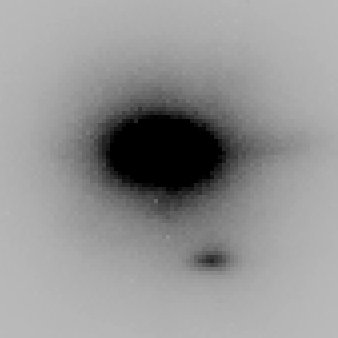Adaptive Optics Observations of Kalliope-Linus
I have been using the Keck II telescope on Mauna Kea, Hawaii and its powerful adaptive optics system since 2001 to search for asteroid companions and to characterize their orbital parameters.
The figure below shows the August 29, 2001 discovery image of a satellite orbiting the 180-km diameter asteroid 22 Kalliope, the first companion detected around an asteroid of taxonomic type M. The observations and analysis resulted in a Science paper (J. L. Margot and M. E. Brown. A low density M-type asteroid in the main belt. Science 300, 1939--1942, 2003).
By September 4, 2001, I had a name in mind for the companion and I emailed the discovery announcement to Linus Torvalds, creator of the Linux operating system ("Have been enjoying Linux for many years... The OS was instrumental in my Ph.D. work and most of my scientific work since then").
In 2003 I sought and received approval from the good folks at United Media to use the Peanuts cartoon character Linus in my talks. They sent me a nice image.


The next General Assembly of the International Astronomical Union (IAU) was scheduled for July 13-26, 2003 in Sydney, Australia. In early June 2003, I submitted a naming proposal to Brian Marsden who chaired the IAU Task Group for Small Bodies Nomenclature at the time. The proposal was to have S/2001 (22) 1, satellite of Kalliope, named "Linus". The official proposal was motivated by the fact that, in various accounts of Greek mythology, Linus is considered the son of Kalliope and the inventor of melody and rhythm. But the name was also meant to honor Linus Torvalds and the Peanuts character. At the 2003 IAU General Assembly in Sydney, the Committee for Small Body Nomenclature unanimously approved the proposal, with backing by the entire Division III - Planetary Systems Sciences.
We also discovered a satellite around 87 Sylvia in 2001. In 2004, another team discovered a second satellite which is not visible in any of the 2001 Keck images. Sylvia became the first triple asteroid system known.